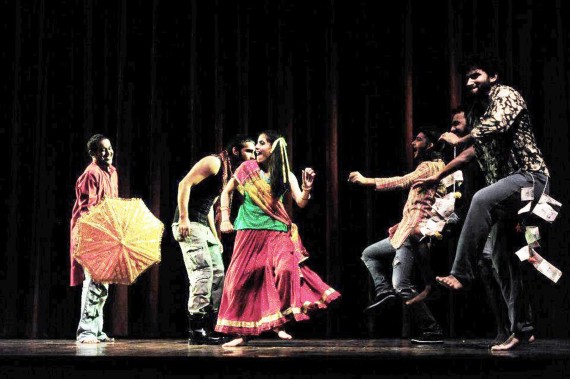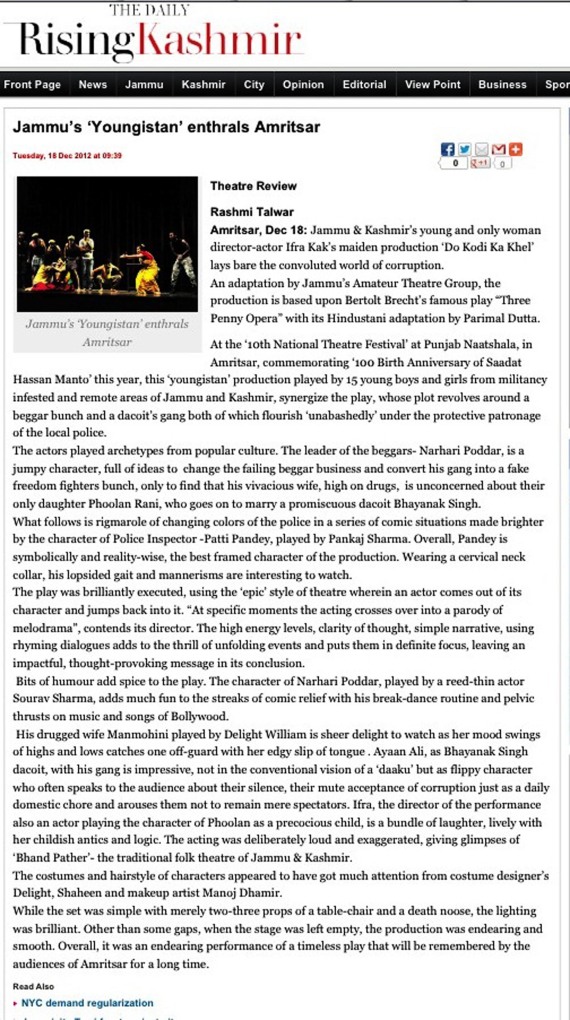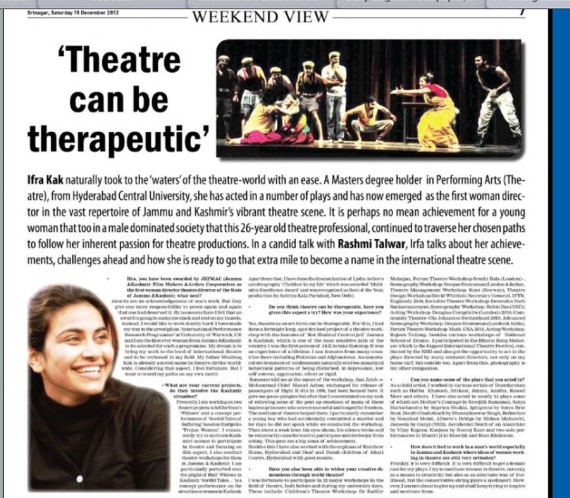Jammu’s ‘Youngistan’ Enthralls Amritsar
By Rashmi Talwar
Jammu & Kashmir’s young and only woman director-actor Ifra Kak’s maiden production ‘Do Kodi Ka Khel’ lays bare the convoluted world of corruption. An adaptation by Jammu’s Amateur Theatre Group, the production is based upon Bertolt Brecht’s famous play “Three Penny Opera” with its Hindustani adaptation by Parimal Dutta.
At the “10th National Theatre Festival” at Punjab Naatshala, in Amritsar, commemorating “100 Birth Anniversary of Saadat Hassan Manto” this year, this ‘youngistan’ production played by 15 young boys and girls from militancy infested and remote areas of Jammu and Kashmir, synergize the play, whose plot revolves around a beggar bunch and a dacoit’s gang both of which flourish ‘unabashedly’ under the protective patronage of the local police.
The actors are playing archetypes from popular culture. The leader of the beggars- Narhari Poddar, is a jumpy character, full of ideas to change the failing beggar business and convert his gang into a fake freedom fighters bunch, only to find that his vivacious wife, high on drugs, is unconcerned about their only daughter Phoolan Rani, who goes on to marry a promiscuous dacoit Bhayanak Singh.
What follows is rigmarole of changing colors of the police in a series of comic situations made brighter by the character of Police Inspector -Patti Pandey, played by Pankaj Sharma. Overall, Pandey is symbolically and reality-wise, the best framed character of the production. Wearing a cervical neck collar, his lopsided gait and mannerisms are interesting to watch.
The play was brilliantly executed, using the ‘epic’ style of theatre wherein an actor comes out of its character and jumps back into it. “At specific moments the acting crosses over into a parody of melodrama”, contends its director. The high energy levels, clarity of thought, simple narrative, using rhyming dialogues adds to the thrill of unfolding events and puts them in definite focus, leaving an impactful, thought-provoking message in its conclusion.
Bits of humour add spice to the goings-on in the play. The character of Narhari Poddar, played by a reed-thin actor Sourav Sharma, adds much fun to the streaks of comic relief with his break-dance routine and pelvic thrusts on music and songs of Bollywood.
His drugged wife Manmohini played by Delight William is sheer delight to watch as her mood swings of highs and lows catches one off-guard with her edgy slip of tongue . Ayaan Ali, as Bhayanak Singh dacoit, with his gang is impressive, not in the conventional vision of a ‘daaku’ but as flippy character who often speaks to the audience about their silence, their mute acceptance of corruption just as a daily domestic chore and arouses them not to remain mere spectators. Ifra, the director of the performance also an actor playing the character of Phoolan as a precocious child, is a bundle of laughter, lively with her childish antics and logic. The acting was deliberately loud and exaggerated, giving glimpses of ‘Bhand Pather’- the traditional folk theatre of Jammu & Kashmir.
The costumes and hairstyle of characters appeared to have got much attention from costume designer Delight, Shaheen and makeup artist Manoj Dhamir.
While the set was simple with merely two-three props of a table-chair and a death noose, the lighting was used brilliantly. Other than some gaps, when the stage was left empty, the production was endearing and smooth. Overall, it was an endearing performance of a timeless play that will be remembered by the audiences of Amritsar for a long time.
FIRST PUBLISHED IN RISING KASHMIR ON DEC-19,2012
URL:http://www.risingkashmir.in/news/jammus-youngistan-enthrals-amritsar-38474.aspx
















Recent Comments